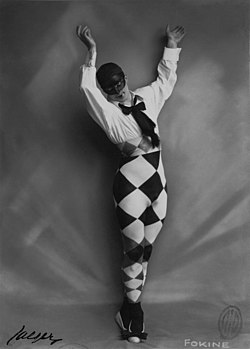Michel Fokine
| Michael Fokine | |
|---|---|

Michel Fokine in Arlequin, 1914
|
|
| Native name | Михаи́л Миха́йлович Фо́кин |
| Born |
Mikhaíl Mikháylovich Fokín 23 April 1880 Saint Petersburg, Russian Empire |
| Died | 22 August 1942 (aged 62) New York City, U.S |
| Nationality | Russian, naturalized U.S. |
| Occupation | Ballet dancer, choreographer |
| Spouse(s) | Vera Fokina |
Michael Fokine (a French transliteration Michel Fokine; English transliteration Mikhail Fokin; Russian: Михаи́л Миха́йлович Фо́кин, Mikhaíl Mikháylovich Fokín) (23 April [O.S. 11 April] 1880 – 22 August 1942) was a groundbreaking Russian choreographer and dancer.
Fokine was born in Saint Petersburg, as son of a prosperous, middle-class merchant and at the age of 9, he was accepted into the Saint Petersburg Imperial Ballet School (Vaganova Ballet Academy). In that same year, he also made his performing debut in the ballet The Talisman under the direction of Marius Petipa. In 1898, on his 18th birthday, he debuted on the stage of the Imperial Mariinsky Theatre in Paquita, with the Imperial Russian Ballet (now the Mariinsky Ballet). Along with being a talented dancer, Fokine also had a passion for painting and displayed great talent in this area as well. He also played musical instruments: mandolin (played on stage in ensemble led by Ginislao Paris), domra and balalaika (played in Vasily Andreyev's Great Russian orchestra) Becoming frustrated with the life of a dancer, he began considering other paths including his painting. In 1902 however, he was offered a teaching position at The Imperial Ballet School. It was here that he was able to explore the artistic possibilities of choreography. Among his students were Desha Delteil and Bronislava Nijinska. In 1905 he created his first full-length ballet, Acis et Galatée, which was performed by his students and based on an ancient Sicilian legend.
Fokine aspired to move beyond stereotypical ballet traditions. Virtuoso ballet techniques to him were not an end in themselves, but a means of expression. He also believed that many of the ballets of his time used costuming and mime that did not reflect the themes conveyed in the ballets. Therefore, Fokine sought to strip ballets of their artificial miming and outdated costumes. Fokine studied Greek and Egyptian art, including vase-painting and sculpture, which aided the development of his themes.
...
Wikipedia
